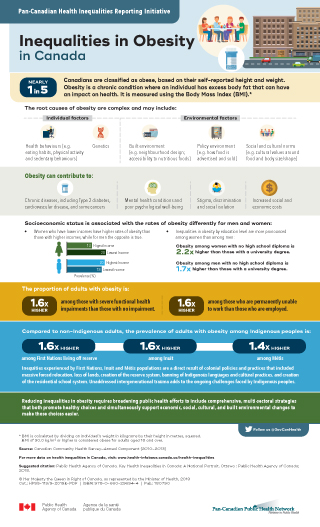Infographic: Inequalities in obesity in Canada

Download the alternative format
(PDF format, 390 KB, 1 page)
Organization: Public Health Agency of Canada
- Cat.: HP35-113/9-2019E-PDF
- ISBN: 978-0-660-29694-4
- Pub.: 180790
Pan-Canadian Health Inequalities Reporting Initiative
Inequalities in Obesity in Canada
Nearly 1 in 5 Canadians are classified as obese, based on their self-reported height and weight. Obesity is a chronic condition where an individual has excess body fat that can have an impact on health. It is measured using the Body Mass Index (BMI).Footnote *
The root causes of obesity are complex and may include:
Individual factors
- Health behaviours (e.g. eating habits, physical activity and sedentary behaviours)
- Genetics
Environmental factors
- Built environment (e.g. neighbourhood design; accessibility to nutritious foods)
- Policy environment (e.g. how food is advertised and sold)
- Social and cultural norms (e.g. cultural values around food and body size/shape)
Obesity can contribute to:
- Chronic diseases, including Type 2 diabetes, cardiovascular disease, and some cancers
- Mental health conditions and poor psychological well-being
- Stigma, discrimination and social isolation
- Increased social and economic costs
Socioeconomic status is associated with the rates of obesity differently for men and women:
| By income | Prevalence (%) | |
|---|---|---|
| Women | Men | |
| Lowest income | 20 | 18 |
| Highest income | 13 | 20 |
Women who have lower incomes have higher rates of obesity than those with higher incomes, while for men the opposite is true.
Inequalities in obesity by education level are more pronounced among women than among men:
- Obesity among women with no high school diploma is 2.2 times higher than those with a university degree.
- Obesity among men with no high school diploma is 1.7 times higher than those with a university degree.
The proportion of adults with obesity is:
- 1.6 times higher among those with severe functional health impairments than those with no impairment.
- 1.6 times higher among those who are permanently unable to work than those who are employed
Compared to non-Indigenous adults, the prevalence of obesity among Indigenous adults is:
- 1.6 times higher among First Nations living off reserve
- 1.6 times higher among Inuit
- 1.4 times higher among Métis
Inequities experienced by First Nations, Inuit and Métis populations are a direct result of colonial policies and practices that included massive forced relocation, loss of lands, creation of the reserve system, banning of Indigenous languages and cultural practices, and creation of the residential school system. Unaddressed intergenerational trauma adds to the ongoing challenges faced by Indigenous peoples.
Reducing inequalities in obesity requires broadening public health efforts to include comprehensive, multi-sectoral strategies that both promote healthy choices and simultaneously support economic, social, cultural, and built environmental changes to make those choices easier.
Follow us @GovCanHealth
Source: Canadian Community Health Survey – Annual Component (2010-2013)
For more data on health inequalities in Canada, visit:
www.health-infobase.canada.ca/health-inequalities
Suggested citation: Public Health Agency of Canada. Key Health Inequalities in Canada: A National Portrait. Ottawa: Public Health Agency of Canada; 2018.
© Her Majesty the Queen in Right of Canada, as represented by the Minister of Health, 2019 | Cat.: HP35-113/9-2019E-PDF | ISBN: 978-0-660-29694-4 | Pub.: 180790